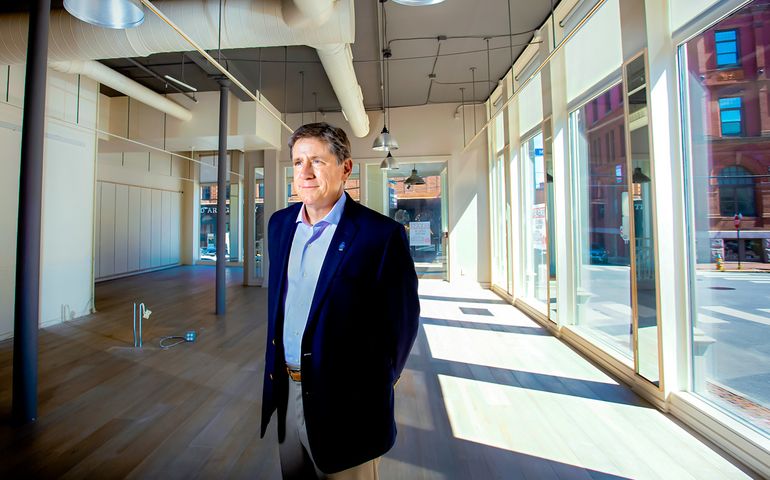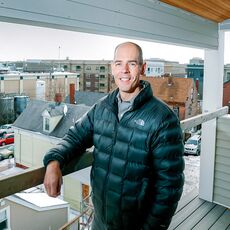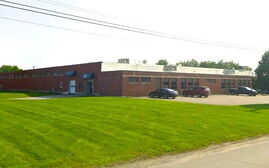
Processing Your Payment
Please do not leave this page until complete. This can take a few moments.
- News
-
Editions
View Digital Editions
Biweekly Issues
- Nov. 17, 2025
- November 03, 2025
- October 20, 2025
- October 6, 2025
- September 22, 2025
- September 8, 2025
- + More
Special Editions
- Lists
- Viewpoints
-
Our Events
Event Info
Award Honorees
- Calendar
- Biz Marketplace
Despite weaknesses in the economy, MEREDA conference showed optimism
 File Photo / Tim Greenway
Pete Harrington has been honored by the Maine Association of Realtors.
File Photo / Tim Greenway
Pete Harrington has been honored by the Maine Association of Realtors.
The annual outlook conference forecast held by the Maine Real Estate & Development Association was loaded with data, charts and diagrams. But it was clear much of the information backed up what Maine had seen in the past year:
- Residential real estate prices hit new highs and in turn spurred new development
- Industrial space continues to be snapped up by cannabis companies and others
- The office market remains strong even as employers navigate hybrid workspaces
- Regional markets have gotten stronger as investors get priced out of Portland.
Overall, the MEREDA conference, held Jan. 20 at the Cross Insurance Arena in Portland, presented a bullish — if nuanced — outlook for the Maine real estate industry in 2022.
A lesson in adaptation for the southern Maine office sector
“The office market and office occupiers are learning to adapt” to the pandemic, says Nate Stevens, a partner and broker with the Boulos Co.
The total 2021 vacancy rate was 6.73%, which was an improvement from 6.9% the year before.

“It’s a tenant’s market. The pandemic put the tenant back in the driver’s seat,” Stevens says. “Options are now there for tenants. There are choices for tenants.”
Portland is actually performing strongly compared with other locales. A recent Boulos survey found that 49% of respondents were fully back in the office in Portland, compared with national rates in the 30% range, Stevens says.
One factor dampening the office market is the amount of sublease space available, with 335,800 square feet of it now on the market.
“The sublease spaces will affect the vacancy rate going forward,” Stevens says.
Overall, the downtown Portland market will continue to improve, but suburban vacancy rates will increase, especially around the Maine Mall area, Stevens says.
“Investors have confidence in offices long term,” Stevens says. “I’m confident in the office space, especially in downtown Portland.”
‘Solid’ 2022 lies ahead for retail real estate in southern Maine
New restaurants snapping up vacant spaces in Portland, along with commercial development in Westbrook’s Rock Row and Scarborough’s “mini-Rock Row” on Route 1, all point to a positive outlook for the southern Maine retail market.
That was the readout from Peter Harrington of Malone Commercial Brokers in his analysis. Going from 2021 to 2022, the sector is “on very solid footing,” he says.
“I’m not saying we’re crushing it, but we’re certainly holding our own,” he adds.
And that solid footing has been more solid than expected during the pandemic.
As for the Maine Mall, Harrington says the current vacancy rate is 8% as the facility looks to diversify to residential, hotel, entertainment and so-called experiential uses.
Current vacancies include 10,000 square feet where Town Buffet had been, 10,000 square feet in the former Pier 1 site and 42,000 square feet in the former H&M and Forever 21 clothing stores. The 113,111-square-foot Sears building, which is not part of the Maine Mall, is also empty and available for sale at a listed price of $11 million.
While it may take a while to find a buyer, Harrington says he wouldn’t be surprised if a big retailer like Costco takes it in the next couple of years. “Will it sit there forever? I don’t think so.”
On the whole this year, “the future for greater Portland and the southern Maine retail market is bright,” Harrington says. Maine’s pluses and attraction as a place to live and visit outweigh challenges such as online shopping, inflation and a lack of labor, he says. “All in all, I think it’ll be a solid 2022.”
Southern Maine industrial space will continue ‘bull run’
The southern Maine industrial market had very few COVID-related hiccups because many industrial businesses were deemed “essential” during the pandemic, says Justin Lamontagne, a designated broker with the Dunham Group.
Warehouse space continues to be tight as online buying has created a need for storage space for deliveries. Meanwhile, the cannabis industry continues to grab industrial space, and they are deep-pocketed customers.

“There’s no amount of price they won’t pay,” says Lamontagne. “It’s created a stifling vacancy rate.”
The vacancy rate in the industrial sector is 1.69%, compared with a national average of 4% to 5% percent, noted Sam LeGeyt with the Dunham Group.
“There was dramatically escalating pricing in sales and leases,” Lamontagne says. “We are mired in a supply and demand imbalance. Landlords have all the leverage and can be selective.”
Lamontagne says he expects the vacancy rate to fall even further in 2022.
“The bull run will continue for the foreseeable future.”
Midcoast Maine played catchup in multifamily development
In central and midcoast Maine, multifamily dwellings also saw strength among buyers, which pushed prices higher in the past year.
“COVID flight to isolation is benefitting the area” around Augusta, says Frank Carr, senior vice president of Maine Realty Advisors.
Waterville and Lewiston-Auburn also are benefitting from that trend, he says.
David Holman, a Realtor with RE/MAX Riverside, says the midcoast towns of Bath, Brunswick and Topsham are seeing growth due to their manageable commuting distance to Portland. Multifamily dwelling also saw a surge in these markets, according to Holman.
“We saw one or two decades of growth in one year,” Holman says of the multifamily market.
Rents have surged in the midcoast, as well. A one-bedroom apartment in Brunswick that fetched $838 per month in 2018 now goes for about $1,348 a month.
“I don’t think this rate of growth is good or sustainable,” Holman says.
Brunswick has benefitted from growth at Brunswick Landing, with more businesses opening there. Holman says job growth in Brunswick was five times that of Maine’s overall job growth.
Going forward, he expects the multifamily market “will cool down from red hot to very warm” amid interest rate increase and recession fears after the midterm elections.
Demand and low rates still driving residential market
For southern Maine’s residential real estate market, 2021 saw longstanding housing shortages fueled to new heights by COVID refugees from other states.

“We already didn’t have enough housing before the pandemic. There’s not enough rentals. There’s not enough homes,” says Brit Vitalius, owner of the Vitalius Real Estate Group.
Buyers saw bidding wars, closing dates set at sellers’ preferences, sellers staying for free until they were ready to move, buyers putting down deposits of 25% to 50%, and buyers bidding on homes they had never seen. Cash buyers had more leverage, but still faced fierce bidding wars.
The influx of out-of-staters was real, representing 35% of buyers. Most of the transplants came from Massachusetts, New Hampshire, Florida and California.
“Some are commuting back to Boston and New York. Some are keeping their jobs” as they relocate to Maine with out-of-state salaries, Vitalius says.
Portland’s rent control rules, which Vitalius says were the strictest in the country, kept rents stagnant in 2021. But towns such as Westbrook, Biddeford and Gorham saw rent increases of 25% and more in the last year.
Among Portland’s smaller multifamily homes, with two to four units, prices increased and all the properties were owner-occupied, rather than being just investments. For homes with more than five units, rent control reduced their value because any improvements couldn’t be spread over higher rental rates.
Portland’s small multifamily buildings will continue to be attractive for owner-occupied buyers, but investors will look elsewhere, Vitalius says.
“Everyone is looking outside” of Portland for investment properties. “Other locations are getting all the attention,” Vitalius says, citing Lewiston-Auburn, Brunswick, Gorham and Windham as increasingly hot markets.
Prices of single-family homes surged in 2021, with the statewide median sale price hitting $299,000 and the southern Maine median sale price reaching $419,000. Throughout the state, sale prices were above asking prices.
Median sale prices rose 14% in Portland, but 43% in Westbrook, 30% in South Portland and 35% in Lewiston-Auburn, says Vitalius.

Prices are expected to keep increasing in 2022, but perhaps at a more modest pace of 7% to 10%, says Dava Davin, founder of Portside Real Estate Group.
Out-of-state demand will level off, but not disappear, she added.
She also expects more growth in rural areas as people get priced out of key markets.
“People will drive until they can afford it,” Davin says.
Bangor spaces are filling up, but there’s capacity
Tanya Emery, economic development director for the city of Bangor, says the real estate market in that area has shown strong signs of growth in the past year.
The office sector is rebounding, retailers and restaurants showed stability and demand for industrial space has been strong.
Of office space, half of the vacancy is tied up in one building, which University of Maine System offices formerly occupied. On the flip side, 396 Griffin St., which was nearly empty in early 2021, has nearly filled its 45,000 square feet of office space.
Significant sales last year include New York developer Dash Davidson buying 2 Hammond St. and 30 State St. downtown. Elsewhere downtown, the former Saliba’s Rug building was acquired by Robert Ervin, an architect.
The Waterfront Concert venue had its lease extended through 2032, and in turn invested $7 million on upgrades.
On the retail and restaurant front, new restaurants include the vegan venue Little Gem and Smoke & Steel BBQ. New retailers include Bob’s Discount Furniture near the mall.
In addition, Emery noted, Husson University completed its College of Business building, Harold Alfond Hall.
To address a “critical need” for housing, two significant properties opened: Newton Place, with 40 units of senior housing, and the Schoolhouse Apartments, with 66 units.

“We still need middle market housing,” Emery added.
Industrial space is also in demand. The vacancy rate is 1%. “We are missing opportunities,” she says. “We simply do not have the space.”
To accommodate demand for industrial and flex space, the city has adjusted zoning to allow for some light manufacturing and warehouse space in shopping areas. The zoning change could open up possibilities for the Bangor Mall’s long-vacant Sears space, which is 92,000 square feet.
Overall, there is land available for industrial development and housing.
Mainebiz web partners
Related Content

The Giving Guide
The Giving Guide helps nonprofits have the opportunity to showcase and differentiate their organizations so that businesses better understand how they can contribute to a nonprofit’s mission and work.
Learn More
Work for ME
Work for ME is a workforce development tool to help Maine’s employers target Maine’s emerging workforce. Work for ME highlights each industry, its impact on Maine’s economy, the jobs available to entry-level workers, the training and education needed to get a career started.
Learn More
Groundbreaking Maine
Whether you’re a developer, financer, architect, or industry enthusiast, Groundbreaking Maine is crafted to be your go-to source for valuable insights in Maine’s real estate and construction community.
Learn more-
The Giving Guide
The Giving Guide helps nonprofits have the opportunity to showcase and differentiate their organizations so that businesses better understand how they can contribute to a nonprofit’s mission and work.
-
Work for ME
Work for ME is a workforce development tool to help Maine’s employers target Maine’s emerging workforce. Work for ME highlights each industry, its impact on Maine’s economy, the jobs available to entry-level workers, the training and education needed to get a career started.
-
Groundbreaking Maine
Whether you’re a developer, financer, architect, or industry enthusiast, Groundbreaking Maine is crafted to be your go-to source for valuable insights in Maine’s real estate and construction community.
ABOUT
NEW ENGLAND BUSINESS MEDIA SITES
No articles left
Get access now
In order to use this feature, we need some information from you. You can also login or register for a free account.
By clicking submit you are agreeing to our cookie usage and Privacy Policy
Already have an account? Login
Already have an account? Login
Want to create an account? Register
Get access now
In order to use this feature, we need some information from you. You can also login or register for a free account.
By clicking submit you are agreeing to our cookie usage and Privacy Policy
Already have an account? Login
Already have an account? Login
Want to create an account? Register











0 Comments